The sorry state of the Nation’s power sector was once again brought to fore as the country was thrown into darkness due to the collapse of the Egbin power station.
What led to the collapse ?
The station collapsed due to a lack of funds to provide ancillary services.
The analysis clearly indicated that there was insufficient level of spinning reserve provided by grid-connected generation companies arising from low tariffs for providing ancillary services.
Why the stations are struggling
Generation companies are currently being owed by distribution companies. Distribution companies currently charge electricity tariffs that do not cover their costs. A move to increase tariffs has been put on hold due to a court order. The government in March 2017 put in place a N701 billion power guarantee programme for the Nigerian Bulk Electricity Trading (NBET) Plc billed to last till 2018. The NBET is the body that buys electricity from generation companies.
Egbin power station was established in 1985 and is the biggest generating station in the country, with a total generating capacity of 1320 megawatts. The station is located in Ikorodu, Lagos State. The Federal Government of Nigeria handed over Egbin Thermal Power Plant to the core investor, a joint venture between Sahara Power Group and KEPCO on the 1st of November, 2013.
Mr Thomas Pealy, MD of Egbin power Plc had recently raised concerns that the station was close to collapse due to debts. Some players in the industry have called for a reversal of the privatization exercise due to the inability of the government to meet conditions agreed. Minister of Power, Works and Housing Babatunde Fashola has however opposed this as the government had spent the proceeds of the exercise, as well as send a wrong signal to investors.





















